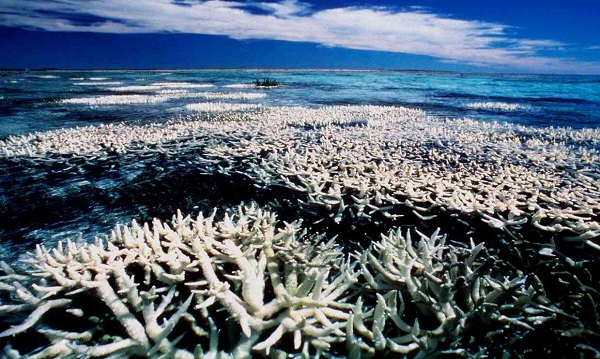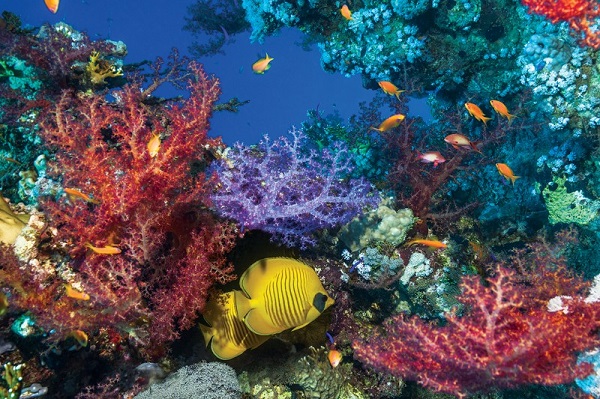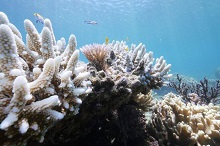Core samples of the Great Barrier Reef going back 400 years show no bleaching before 1998. There was another event in 2002. In those events less than 20% of reefs were bleached in the affected zones. This year 95 per cent of the Great Barrier Reef’s northern reefs were rated as severely bleached. Only 4 out of 520 reefs surveyed, less than one per cent, were found to be unaffected by bleaching.
The bleaching is destroying the northern sector of the Reef as we watch.

This is what a really healthy reef looks like:

The SMH has some startling images of what’s been happening.
Terry Hughes, a professor at James Cook University and convener of the National Coral Bleaching Taskforce, led the survey team last week using planes and helicopters. He says the situation is now critical:
- “This will change the Great Barrier Reef forever,” Professor Hughes told 7.30.
“We’re seeing huge levels of bleaching in the northern thousand-kilometre stretch of the Great Barrier Reef.”
Of the 520 reefs he surveyed, only four showed no evidence of bleaching.
From Cairns to the Torres Strait, the once colourful ribbons of reef are a ghostly white.
He says it’s too early to tell, but he thinks half of the affected reefs will die. For the rest, he told the 7.30 Report, we are looking at a 10-year recovery period.
Some reefs have been bleached twice and possibly three times since 2014. With current temperature trends we can expect more bleaching within the next 10 years.
Professor Justin Marshall from the University of Queensland:
- The prognosis just gets worse and worse as more of these global events occur. I guess what upsets me the most is that we are literally stealing the future from our children. I’m going to be dead within 30 years. I probably won’t see the possible end of the Great Barrier Reef. But it’s possible that my grandchildren will and that really upsets me.
Environment Minister Greg Hunt wasn’t available for on camera interview, but talked up the positive. The reef was 2300 kilometres long, the bottom 75% of it was pretty much OK. He’s been saying that the Australian and Queensland governments are investing around $2 billion over the next decade to protect the Great Barrier Reef. They will monitor what happens, they are working on water quality, we are meeting and beating our targets, etc, etc.
The scientists want to see action on climate change. To them Australia has not yet joined the group of countries that are taking the Paris conference last December seriously. Hughes told The World Today:
- The $2 billion figure is much bandied around. It’s basically the operating budget for all the agencies that have anything remotely to do with the Great Barrier Reef.
So the Minister hasn’t yet announced a significant response other than paying for more surveys of dead corals.
I don’t think many people would regard that as an adequate response.
Really in the longer term what’s needed is a change in policy around Australia’s greenhouse gas emissions that would be favourable to the Great Barrier Reef.
So many people would regard issuing a permit for a new coal mine in Queensland for the next 60 years as a profound policy failure for the Great Barrier Reef.
So certainly the science community is hoping that the Federal Government will look again at our emissions trajectory which is trending upwards, and also putting back the price on carbon, and at not cutting the renewable energy target by 30 per cent.
The Queensland government has called on Turnbull to show as much interest as Abbott and at least visit the Reef.
In The Folly of two degrees in December 2014 I quoted David Spratt:
- It has been shown that “preserving more than 10 per cent of coral reefs worldwide would require limiting warming to below +1.5°C (atmosphere–ocean general circulation models (AOGCMs) range: 1.3–1.8°C) relative to pre-industrial levels”.
I believe the Great Barrier Reef generates about 70,000 jobs and $5 billion each year in revenue. As the waves roll in and we look forward to surfing, remember the Irukandji jellyfish is finding climate change quite congenial!
Update: Further reports on 7 April and 11 April update the damage. The most severe bleaching is north of Cairns, with patchy bleaching almost as far south as Mackay, with “reasonable” levels of bleaching down to Great Keppel Island, near Rockhampton.
It seems at tourist centres there are “reefs that are still in good condition.”
The 95% figure relates to reefs between Cairns and Papua New Guinea.
Cyclone Winston out in the Coral Sea was responsible for bringing cooler water to the central and southern sections of the reef. Also there were higher tides around Mackay, which brought in cooler water.
During aerial surveys, each reef is given a score from 0, indicating no bleaching, to 4, indicating that more than 60% of the corals are bleached.
In 1998 and 2002 fewer than 200 reefs were assigned categories 3 an 4. By 7 April 2016 the number was 450.
See also new post, Coral reef resilience.


It’s one of those ‘words fail me’ moments isn’t it? One of the world’s great natural wonders and we are destroying it. What will it take to make people wake up?
I think scientists need to speak very clearly about this. I know scientists are scared to overstate their case, so tend to speak very cautiously. However when people go to vote in the coming election, they need to know that losing the reef in the lifetimes of current generations is a real possibility unless we act decisively on climate change now.
Val, I suspect it’s a real wake-up call. Hunt has reacted like the Iraqi information minister, who kept spruiking how well they were doing as the tanks rolled towards Baghdad.
With the El Nino disintegrating next summer will probably be cooler and probably the next couple of years too, bringing complacency. However, bleaching will almost certainly be back before the 10 years required for recovery is out.
Brian
With the expected flip to LaNina the cyclone frequency should escalate at the Cape resulting in massive run off and silt causing untold damage to the northern GBR, right ?
No time for complacency i feel, it’s ashes on our heads and wailing for the foreseeable future.
How far back do we have coral core data, I thought it was in the tens of thousands of years ?
Jumpy, there’s no evidence we will have more cyclones with global warming. They suspect we will have more stronger ones. We don’t know how many will make landfall. Personally I don’t know whether silt is a big problem from Townsville north. The quality of the reefs before they were bleached suggests it isn’t.
On core data, previously I’d only heard of 300 years. Not sure why we can’t go back further, but you’d find it difficult to go back past 10,000 years because the sea level would have been lower during the last Ice Age.
I was taking of ElNino/LaNina affect on cyclone frequency Brian, didn’t mention co2 at all.
I’ll not link to any coral core statements and studies about timelines for fear of picking a ” non-prefered ” scientist or publisher.
I’ll await your findings should you care to first search and then share them.
Is that what happened with previous flips to La Nina?
(I’ll leave it to Jumpy to do the research, since he wouldn’t accept the word of any scientist I quoted.)
Jumpy, I don’t know what your problem is with preferred scientists. We are talking about the Great Barrier Reef. They’ll almost certainly be from James Cook or UQ.
We know that reefs have been around for hundreds of millions of years.
You’ve obviously got something you could share, so why not do it?
That’s a novel approach.
Care to explain how it will reduce the abnormally high sea temperatures which are the cause of the problem?
(Mind you, if it does you’ll be in line for a Nobel Prize.)
Greg Hunt is wrong according to The Australian Institute of Marine Science, it has increased in coral cover by quite a lot.
In fact the GBR as a whole had an increase coral cover in the last 5 years.
It would be useful to know what the range of temperatures are that coral can survive in and to what extent changes in the symbiotic algae change this temperature range.
I may be wrong but I would have thought that the waters around places like Groote Eylandt would have had higher temperatures than the Northern waters of the GBR.
John
They tend to prefer the warmer water it seems.
The Red Sea Reef sits between the Sahara and Arabian Deserts. It’s big and healthy. Not sure about the salinity.
John, I think coral is acclimatised to wherever it is, but tends to thrive within a certain bandwidth. It adapts to some extent, but not if change occurs rapidly. But I’m no expert.
Jumpy, thanks for the links, but you don’t tell the story.
Seems the GBR lost half its cover from 1985 to 2012. During the three-year period 2012 – 2015 there was recovery in the Central and Southern sectors, but a loss in the Northern sector, mainly through a cyclone and the crown of thorns starfish. However, that report was before the most recent bleaching event.
Further reports on 7 April and 11 April update the damage. The most severe bleaching is north of Cairns, with patchy bleaching almost as far south as Mackay, with “reasonable” levels of bleaching down to Great Keppel Island, near Rockhampton.
It seems at tourist centres there are “reefs that are still in good condition.”
The 95% figure relates to reefs between Cairns and Papua New Guinea.
Cyclone Winston out in the Coral Sea was responsible for bringing cooler water to the central and southern sections of the reef. Also there were higher tides around Mackay, which brought in cooler water.
During aerial surveys, each reef is given a score from 0, indicating no bleaching, to 4, indicating that more than 60% of the corals are bleached.
In 1998 and 2002 fewer than 200 reefs were assigned categories 3 an 4. By 7 April 2016 the number was 450.
See also new post, Coral reef resilience.